Japan
Wood Products Prices
Dollar Exchange Rates of 25th
October
2019
Japan Yen 108.88
Reports From Japan
¡¡
Impact of typhoon damage on economy
clouds other
issues such as tax increase
A press release from Markit Economics says the Japanese
economy is at risk of contracting as business activity
slumped in October following the 1 October sales tax
increase. However, analysts at Makit say the extent to
which the tax change has pulled down economic activity
has been clouded as a result of the recent typhoon related
disasters which has impacted the economy.
The latest Markit survey indicates October business
activity declined for the first time in three years and
prospects for the year ahead are not bright.
In the October issue of its World Economic Outlook, the
International Monetary Fund kept its forecast for Japan's
economic growth at 0.9 percent this year and predicted
that it will slow to 0.5 percent next year.
Japan¡¯s Cabinet Office downgraded its assessment of
economic fundamentals to "deteriorating" after data
showed that exports and production were faltering as a
result of an economic slowdown in major overseas
markets.
See:
https://www.markiteconomics.com/Public/Home/PressRelease/ddfd100b9b404ca994338a9d25cf0280
Bank of Japan ready to counter risks to growth
prospects
While there is some hope that the US and China will move
their ¡®first stage¡¯ trade deal further and news that UK will
not crash out of the European Union the continued level of
uncertainty in global demand suggests the US may move
to cut interest rates for a third time.
In Japan the governor of the Bank of Japan (BoJ) has said
the Bank will not hesitate to lower interest rates further if
it needed to ease monetary policy to counter the growing
risks to Japan¡¯s growth prospects.
The stance of the BoJ governor underlines concerns on
global demand prospects due to the US/China trade war.
The pronouncements from the BoJ governor are clear
signals that the Bank is ready to act pushing short term
interest rates even lower. What the Bank fears is a
strengthening of the yen against the dollar which would be
bad news for exporters and the economy.
Retail sales surge - furniture and home furnishing
snapped up before tax hike
Department store sales in Japan soared 23% in September
from a year earlier as consumers were out in force for lastminute
shopping before the consumption tax was raised
and this pushed up retails sales for the second consecutive
month according to the Japan Department Stores
Association.
High priced items were in demand and there was a
doubling of monthly sales of art, jewelry and precious
metals and furniture and home furnishing also sold well.
While the sales tax was one issue driving September sales,
the huge year on year rise in September sales was partly
because 2018 September sales were depressed due to the
effect of a series of natural disasters according to the
Association.
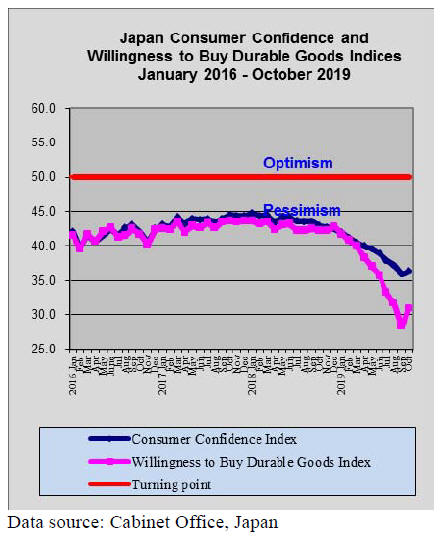
Exchange rate remarkably stable
The Japanese yen exchange rate against the US dollar has
been remarkably stable for the year to date and analysts
anticipate that the yen/dollar exchange rate will be
between yen 105-110 for the balance of the year. As
optimism for a lowering of tensions between the US and
China grow and as the UK will no longer crash out of the
EU this stability should be reinforced. The current
exchange rate of around 108 to the US dollar is supporting
exporters who suffer when the yen strengthens.
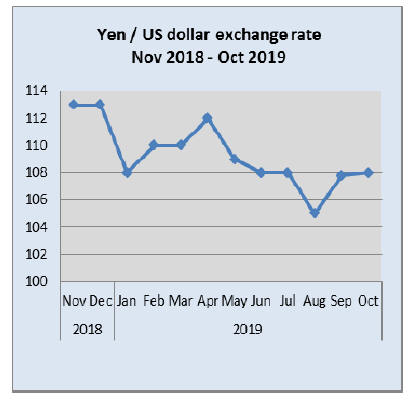
Another catastrophic typhoon ¨C extensive
damage to
homes reported
The 21st typhoon of 2019 thunder across Japan in Octber
adding to the damage left by typhoon number 19 and
inflicting damage on new areas across the country, areas
that are unaccustomed to severe typhoons.
Japan¡¯s Fire and Disaster Management Agency reported
on 20 October that 56,753 homes were damaged by
Typhoon Hagibis (the 21st of this year) exceeding the
51,110 houses that were damaged by flooding in Western
Japan in July last year.
The number of houses submerged above floor level in the
21st typhoon of the year is over four times that in July
2018 when around 7,000 houses suffered similar damage.
Typhoon Hagibis was one of the severest natural disasters
in recent years.
The Ministry of Agriculture has estimated the damage to
the farming, forestry and fishery industries at US$1.5
billion.
Japan¡¯s housing starts fell again year on year in September
despite a slight month on month uptick.
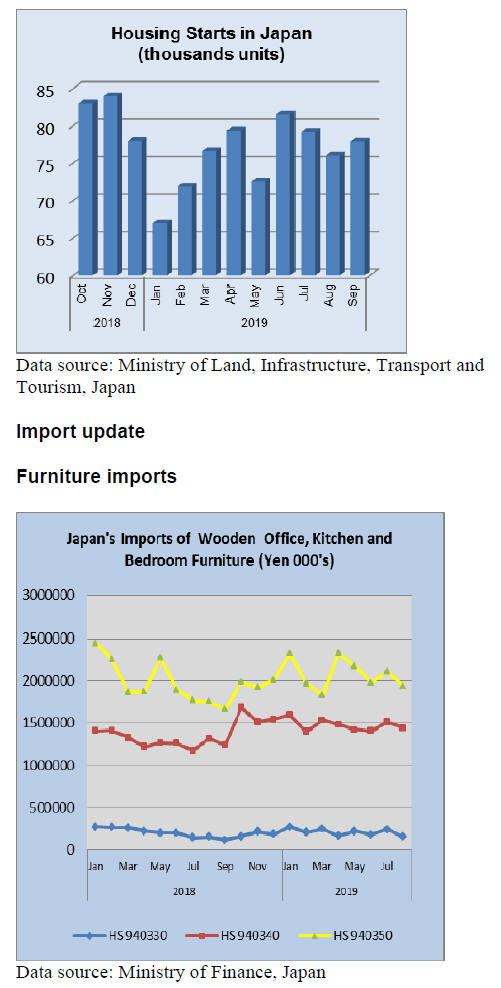
Japan is a major importer of wooden furniture and
parts
but what is often overlooked is that the country is also a
significant exporter of wooden furniture shipping around
US$3.2 bil. in 2018. The table below shows exports to
major regions of the world.
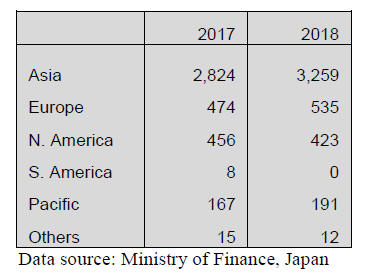
Shipments to Asian markets account for over 70% of
all
shipments of wooden furniture from Japan. China
represents the largest Asian market taking a quarter of all
shipments to Asian countries followed by South Korea
(16%), Hong Kong (14%) and Taiwan P.o.C (13%). The
second main market region is Europe where shipments
enter via Denmark, Holland and Belgium.
Office furniture imports (HS 940330)
After the sharp year on year rise in the value of imports of
wooden office furniture (HS 940330) in July, August year
on year imports were flat but month on month they rose
just over 35%.
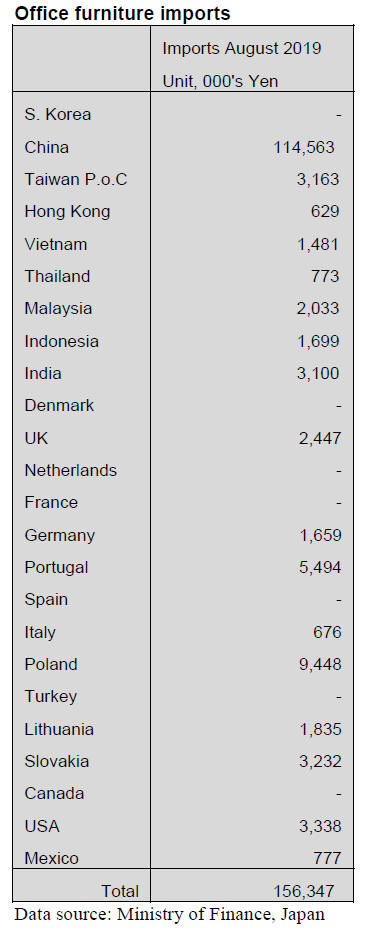
Shipments of office furniture from China surged in
August
and accounted for almost 75% of all wooden furniture
imports. The other two significant shippers were Poland
(6% of import values) and Portugal (4% of import values).
Shipments of wooden office furniture from shippers
outside of Asia accounted for just 28% of August arrivals.
Kitchen furniture imports (HS 940340)
Exporters of wooden kitchen furniture to Japan have great
difficulty capturing market share from the top two
suppliers, the Philippines and Vietnam which accounted
for 44% and 41% respectively of all August arrivals of
wooden kitchen furniture.
Year on year August import values were up 9% but month
on month August imports dropped 5%. As in previous
months China is not a major supplier of wooden kitchen
furniture for the Japanese market neither are shippers in
Europe or North America.
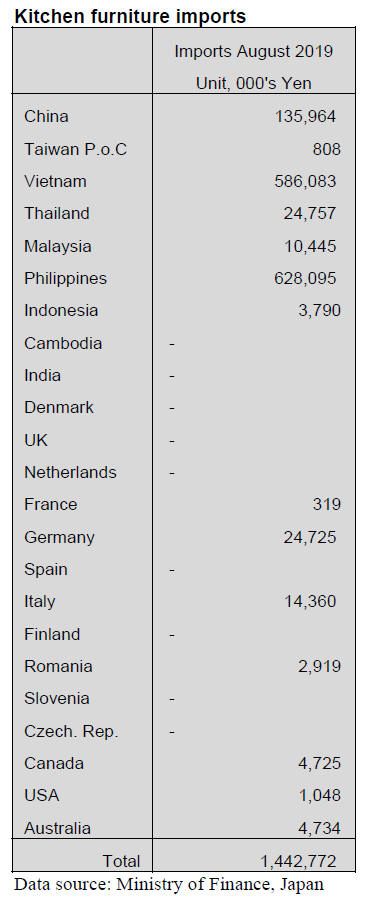
Bedroom furniture imports (HS 940350)
China¡¯s dominance of Japan¡¯s imports of wooden
bedroom furniture (HS 940350) extended into August as
around 55% of all arrivals of wooden bedroom furniture in
the month were from China.

August shipments of bedroom furniture from China
were
about 5% up on the value of July shipments. Exporters in
Vietnam held onto their second rank in term of the value
of shipments to Japan and in August accounted for 34% of
all wooden bedroom furniture imports into Japan.
Year on year value of shipments of wooden bedroom
furniture to Japan in August were up 10% but there was an
8% decline month on month.
Trade news from the Japan Lumber Reports (JLR)
The Japan Lumber Reports (JLR), a subscription trade
journal published every two weeks in English, is
generously allowing the ITTO Tropical Timber Market
Report to reproduce news on the Japanese market
precisely as it appears in the JLR.
For the JLR report please see:
http://www.n-mokuzai.com/modules/general/index.php?id=7
Inflating ocean freight
New rule to use low sulphur oil regulated by the
International Maritime Organization will be applied since
January 1, 2020. This is for marine and air pollution
prevention and the rule is applied worldwide.
Some shipping companies have started switching to low
sulphur content fuel. The new rule regulates present
sulphur content of fuel oil from present 3.5% or less to
0.5% or less. Price difference between present oil and new
regulated oil is almost US$200 per tonne so this extra cost
will be added on ocean freight.
Changing to low sulphur content oil is the most convenient
measure for shipping companies. Another option is to
install exhaust gas purification equipment named scrubber
on a ship, which is costly and takes time about a month for
installation or switching fuel from oil to LNG, which
means to build a new ship.
Oil prices fluctuate daily but as of October 16, price of oil
of sulphur content of 3.5% or less is $355 per ton but of
oil of sulphur content of 0.5% or less is $533 so difference
is US$180 per tonne.
For instance, in case of hauling Canadian wood pellet
(loading of 25,000 tonne) with oil consumption of 700
tonne, additional cost would be about US$5 per tonne,
about more than 10% higher than present freight.
However, ocean freight fluctuate not only by oil cost but
other factors like demand and supply of cargo ships and
availability of return cargoes so freight is decided by
individual negotiations but shipping companies are
determined to pass additional oil cost onto freight.
In case of North American wood pellet, long term contract
of more than ten years is normal and this additional freight
factor is counted in but imported biomass fuel like wood
pellet and PKS from South East Asia is largely affected by
this change. Indonesian PKS freight is now US$24-30 per
tonne (full load with one port loading and one port
discharging) then after fuel change, additional cost would
be about US$3-6 per tonne.
On other cargoes, shipping companies and charterers set
freight once a year and to cover fluctuation of oil market,
they use bunker adjustment factor (BAF) like fuel
surcharge airlines use for jet fuel.
All the charterers agreed to accept BAF for cargoes like
coal and iron ore for which long term contract for several
years. Container ships are normally set the rate once a year
in spring time.
Liaison meeting for CLT use promotion
Relative government offices held liaison meeting to
discuss promotion of CLT use on September 30. Domestic
CLT production increased to 80,000 cbms but the demand
is about 18,000 cbms with very little growth. Buildings
which use CLT were 18 in 2014, 25 in 2015, 47 in 2016,
89 in 2017, 113 in 2018 and 116 in 2019.
Number of building has been increasing steadily but
amount of use of CLT is limited so total number of
building does not necessarily mean increase use of CLT.
Target of CLT production is 500,000 cbms by 2025 so the
production continues to grow. Challenge is how to
increase the demand.
Immediate issue is to reduce the cost of CLT down to yen
70,000-80,000 cbms, which is about half of present cost,
which is competitive with other structures. The Forestry
Agency, the Ministry of Land, Infrastructure and
Transport, the Ministry of Environment continue to give
subsidy to the building with CLT.
In 2019, buildings with CLT will be total of 116. By the
area, Kochi prefecture has 13, Okayama prefecture has 11,
Tokyo 8, Hokkaido 7, Kagoshima 6, three prefecture of
Aichi, Fukushima and Ehime has 5 each. Type of building
with CLT is office, multi family unit, public housing, store
and warehouse. Public hall and assembly hall have been
increasing since 2017. As of last July, there are confirmed
52 buildings with CLT after 2020.
South Sea (tropical) logs
With steady supply from PNG, the Japanese plywood
mills carry ample log inventories as the demand for South
Sea hardwood plywood does not grow. However, the log
supply from South Sea countries always has uncertain
factors so the plywood mills and South Sea hardwood log
users always look for substituting supply of different
species.
Market of free board is pausing now but demand for shop
interior finishing should show up in later this year so it
should get busy again. The market of imported LVL for
crating and condominium stud is slow. Chinese LVL for
building materials is relatively busy.
Decreasing Russian log import
Russian softwood log import for the first eight months of
this year was 77,894 cbms, 15.8% less than the same
period of last year. Decrease of Far Eastern larch logs is
the largest after log export duty increased to 40%.
Red pine logs from Siberia were 25,808 cbms, 51.3%
more and whitewood from Far East was 4,268 cbms,
26.5% more. Larch logs from the Russian Far East was
45,962 cbms, 36.2% less.
Reason of red pine log import increase is that sawmills in
Japan bought more logs because of quality and shipment
time of genban is uneven and soaring prices. Red pine log
import in May was 6,633 cbms and 7,956 cbms in June,
which were more than larch logs.
On Far East larch logs, preferred log export quota is
allocated to forest products companies, which satisfy
certain amount of wood processing but log suppliers
which have no such processing are imposed 40% export
duty.
The duty rate would be raised by 20 points more in 2020
so availability of Far East larch logs will be much tighter.
Import of larch logs was almost 100,000 cbms in 2018 but
it will be far less this year. The export prices have not
changed much at about US$190 per cbm CIF on red pine
and US$190-200 on larch.
Meanwhile, lumber import for the first eight months was
446,597 cbms, 0.4% more but low grade lumber is getting
larger in volume so the market is divided into two of high
to medium grade and low grade. Low grade market is
weak with heavy inventory.
Import of European lumber through polar route
Tomakomai wharf and port management union in
Hokkaido has done trial shipment of European lumber
through polar route. Chinese shipping company, Cosco
group¡¯s ship sailed Helsinki, Finland on September 13 and
arrived Tomakomai¡¯s container terminal on October 9
through Arctic Ocean and unloaded 20 40 feet containers
of European lumber.
Voyage through Arctic Ocean from Europe is more than
10 days shorter than the route through Suez Canal but the
Arctic Ocean in not navigable in winter time with solid ice
so the navigable season is limited from July through
October.
Cosco makes about 50-60 times of the trip a year by this
route from Europe to China and Tomakomai Port
considers to use this route not only import but also export
business. This is newly developed route after ice is
reduced by global warming and advanced ice breaking
ship.
|